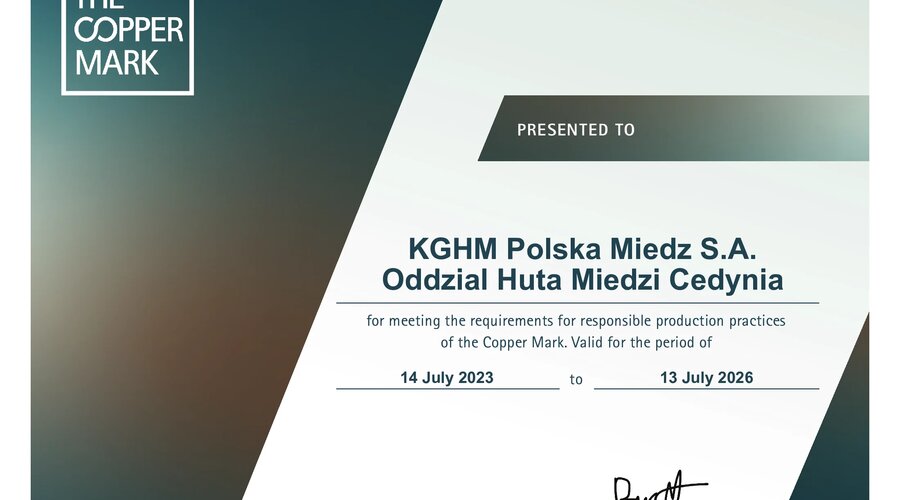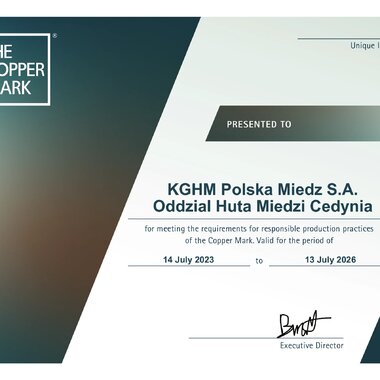The Cedynia Copper Wire Rod plant has been granted the prestigious Copper Mark certificate
KGHM’s Cedynia Copper Wire Rod plant has been granted the prestigious Copper Mark certificate and the right to use the Copper Mark trademark. The copper company’s semis-fabricator division is the world’s first stand-alone wire rod plant to be granted this distinction. This certification demonstrates that the plant efficiently produces copper in compliance with the highest standards.
Since 2021, KGHM’s two other metallurgical facilities – the Głogów and Legnica Copper Smelter/Refineries – have also been granted certification under The Copper Mark.
– All of KGHM’s metallurgical facilities meet the world’s highest environmental, social, and governance standards for production. We comply with environmental norms, we care about our surroundings and have solid working relationships with our local communities. This distinction for the Cedynia Copper Wire Rod plant testifies to KGHM’s position as a global leader in the mining sector – said Tomasz Zdzikot, President of the Management Board of KGHM Polska Miedź S.A.
The Cedynia Copper Wire Rod plant met the 32 criteria required for certification under the Copper Mark. Activities involving environmental protection, mineral supply chains, working conditions, employee rights, risk management practices and community relations were examined. This certificate is currently the market standard and enables KGHM to effectively compete on the processed copper products market.
– The Cedynia Copper Wire Rod plant is a modern rolling mill which is constantly implementing new production techniques and acts in compliance with all environmental norms. We recently brought a prototype machine for cutting granules into operation which meets all expectations. Hundreds of meters of rod and wire are cut to ideal, measured lengths, and twice as fast as before. At present the plant can produce 4 thousand tonnes of granules per year, whereas previously we could do 2 thousand tonnes – says Ryszard Jaśkowski, executive director of the Cedynia Copper Wire Rod plant.
KGHM has metallurgical facilities in Głogów and Legnica as well as the Cedynia Copper Wire Rod plant. In each of them, production is based of different technologies. In 2022, KGHM’s metallurgical facilities employed over 3 600 people. In addition to copper, silver and gold, KGHM’s metallurgical facilities also produce crude and refined lead, sulphuric acid, nickel sulphate and selenium.
The granting of Copper Mark certification to KGHM’s plants attests to the copper company’s actions to protect the environment. This year, KGHM ordered an analysis of the environmental and carbon footprint of its products: cathodes, wire rod and Cu-OFE rod. The Mineral and Energy Economy Research Institute of the Polish Academy of Sciences conducted the analysis in accordance with ISO standards and prepared environmental declarations. The copper products produced by KGHM have a lower footprint than the global average.
The analyses conducted confirmed that KGHM’s metallurgical facilities (the Legnica Copper Smelter and Refinery, the Głogów Copper Smelter and Refinery and the Cedynia Copper Wire Rod plant) produce metals in a responsible manner and in compliance with the highest standards. The metallurgical facilities operate under the ISO 14001 Environmental Management System.
The Cedynia Copper Wire Rod plant’s main product – 8 mm copper wire rod – is produced through the Contirod® continuous process of melting, casting and drawing, mainly from cathodes manufactured by KGHM Polska Miedź S.A. The Cedynia Copper Wire Rod plant produces wire rod in five classes of quality, depending on the needs of the customer. The product is primarily used in the cable, electromechanical and electrotechnical industries. The wire rod market, due to the quality characteristics of the product, is highly competitive and demanding.
In 2022, production of wire rod and wire by KGHM Polska Miedź S.A. amounted to 284.8 thousand tonnes, or nearly 11% of European production. This result makes the Company one of Europe’s leading producers of these copper half-finished products.
About The Copper Mark
The Copper Mark is the leading assurance framework for copper, molybdenum, nickel and zinc. Their vision is a sustainable society, enabled by the responsible production, sourcing, and recycling of these metals. They are working to develop responsible value chains from the mine level to the end-product.
Through their standards and assurance framework, The Copper Mark supports their participants to identify and make on-the-ground changes to their operations. The Copper Mark requirements cover all major environmental, social and governance issues to ensure their participants prevent, mitigate and remedy adverse impacts on people and the environment and contribute positively to the communities in which they operate.
Over 25% of globally mined copper is currently produced by Copper Mark-assured sites.









